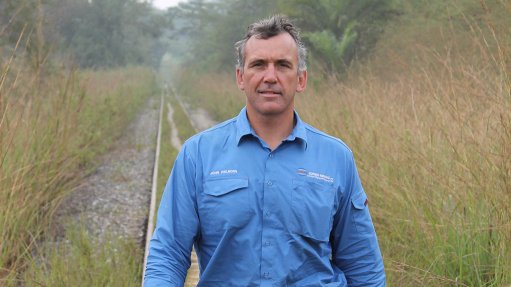
Equatorial CEO John Welborn
JOHANNESBURG (miningweekly.com) – Iron-ore exploration and development company Equatorial Resources hopes to secure a licence to mine iron-ore in the Republic of Congo (RoC) by the end of the first quarter of 2014.
“I’ve tasked our government relations team with putting a priority on working with the government and I’d hope that we could receive the mining licence at the end of the first quarter of 2014,” says Equatorial CEO John Welborn.
He spoke to Mining Weekly Online shortly after the company announced the completion of its licence submission in just over three years since exploration began.
He is not fazed by iron-ore miner Sundance Resources having to wait for more than a year to receive its licence and points rather to JSE-listed Exxaro having its RoC mining licence application approved in five months.
ASX-listed Equatorial’s wholly owned Mayoko-Moussondji iron project is said to be highly prospective with significant scale potential.
The former Australian rugby forward who regularly locked down against Springbok scrums as a Wallaby says that a template for companies to follow has arisen as the mining industry has developed in the RoC.
Equatorial has worked closely with RoC’s mining ministry, using Congolese geologists to assist in compiling the application and Congolese consultants to do the environmental impact assessment study.
“We’ve spent quite a lot of time making sure that our application conforms,” he says, adding delays generally occur an aspect of the mining code has not been covered in the application.
Equatorial, Exxaro and the London- and now also Johannesburg-listed Glencore are all building iron-ore mines of similar size in RoC, where port and rail are being prepared to cope with bulk.
Glencore’s new plan is to fast-track small-scale initial production from its Zanaga project, with all three companies looking to do roughly two-million tons a year from three projects in the southwest of RoC.
“What’s obvious is the need for all of the companies to cooperate,” says Welborn.
The government has made it clear that the fiscal terms for one company will be the same for all companies and, in relation to the port expansion, one area will be allocated to bulk commodities and the model is to have a central logistics function in the container terminal, which has already happened in the case of oil and gas.
“We share a railway and there are many opportunities for synergy,” adds Welborn, who describes his $234-million project as already “well-funded” through not yet fully funded.
Definitive rail and port allocation is expected to be agreed as soon as next year, Equatorial applying for a two-million-ton-a-year rail allocation and access to export facilities for Panamax vessels at Pointe-Noire.
Welborn sees no impediments in the way of funding Mayoko-Moussandji during 2014, through a combination of raising equity capital, clinching an offtake agreement and leasing rail rolling stock.
The company itself has $50-million in cash and no debt and is being supported by its institutional shareholders.
Iron-ore prices have also not fallen to the extent that some expected.
Exxaro’s Mayoko project, located in the Niari Prefecture, about 300 km north-east of Pointe-Noire, on the Atlantic Ocean, is a near-term development in an emerging iron-ore province with the existing underused, heavy-haulage mineral railway passing within 2 km of the main prospect and terminating at the Port of Pointe-Noire.
The project currently has a Joint Ore Reserves Committee-compliant mineral resource of 121-million tons of iron-ore, consisting of a hematite cap of direct shipping ore at 55% iron and beneficiable direct shipping ore at 41% iron.
Production and export of ten-million tons a year of iron-ore by 2016 is envisaged.
Exxaro has described the rail corridor as being “worth its weight in gold”.
The Cameroon-Congo-Gabon region, which is often likened to Australia’s iron-ore-rich Pilbara, is said to need a champion in the mould of Fortescue founder Andrew Forrest to assemble companies, governments, financiers and end-users in a region that could in time give the iron-ore top three of Vale, BHP Billiton and Rio Tinto more of a run for their money.
The ‘each company for itself’ approach of Rio Tinto and BHP Billiton with regard to Pilbara infrastructure is seen as how not to do it in Africa.